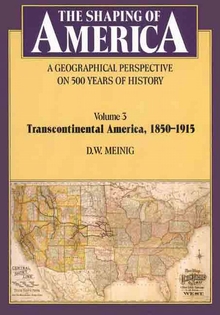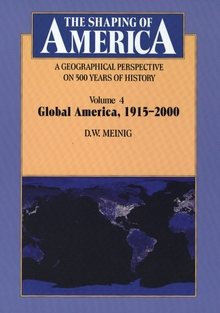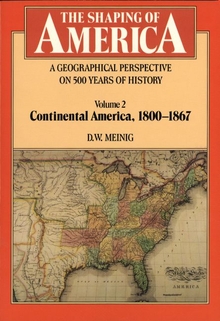The Shaping of America
WARNING
You are viewing an older version of the Yalebooks website. Please visit out new website with more updated information and a better user experience: https://www.yalebooks.com
A Geographical Perspective on 500 Years of History, Volume 1: Atlantic America 1492-1800
D. W. Meinig
This entirely fresh interpretation of American history by a renowned historical geographer is the first in a projected three-volume series. Meinig here focuses on colonial America, examining how an immense diversity of ethnic and religious groups—Europeans, Africans, American Indians—ultimately created a set of distinct regional societies. Richly illustrated with more then forty specially prepared maps and contemporary illustrations, this volume prompts us to rethink the settling of North America.
“A standard work in its field. . . . For readers seeking a bird’s-eye view of early American geography. . . there is no better guide available.”—William Cronon, New York Times Book Review
“Simply the best book in the English language by a contemporary geographer I have read over the past forty-odd years, and one of the most important. . . . A magisterial achievement, a grand shaking up and reassembling of fact and ideas.”—Wilbur Zelinsky, Journal of Geography
“All historians of the American experience should read and come to terms with this book.”—Malcolm J. Rohrbough, Georgia Historical Quarterly
“This book is a masterpiece in the best and old sense of the word.”—Alfred W. Crosby, Southwestern Historical Quarterly
A selection of the History Book Club
"The Shaping of America will stand for generations as a research and publishing milestone. Its scope is simply breathtaking. . . . There can be no doubt about the superb and sustained scholarship exhibited by The Shaping of America. It is a truly astonishing achievement. . . . Meinig's project is simply stunning in its ambition as well as outstanding in its achievement. Its scope and its completion mark it as one of the most remarkable products of North American geography during the twentieth century."—Alan R.H. Baker, Journal of Historical Geography
"One of modern geography's most substantial achievements. . . . The project, taken as a whole and at face value, evokes the same sort of awe as (and many of the superlatives used to describe) the Grand Canyon. . . . The resulting volumes are notable feats of condensation, integration and interpretation. Each rests upon prodigious reading and the intelligent assimilation of arguments new and old advanced by scholars from a number of disciplines. In every volume, indeed it is no exaggeration to say on every page of every volume, Meinig writes with skill and care. . . . There can be no doubt that it is a remarkable achievement, one of the great accomplishments of twentieth century American geography. Meinig can only be admired for the scope of this ambitious project and the consummate skill and dogged resolve with which he brought it to fruition. He has painted a coherent and often compelling picture on a canvas far larger than most geographers have thought to address and which hardly any seem likely to engage in the future."—Graeme Wynn, Journal of Historical Geography
Publication Date: July 27, 1988
87 b/w illus.










